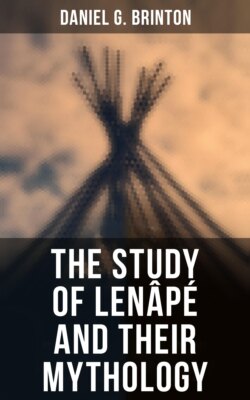Читать книгу The Study of Lenâpé and Their Mythology - Daniel G. Brinton - Страница 16
На сайте Литреса книга снята с продажи.
The Shawnees.
ОглавлениеTable of Contents
The wanderings of the unstable and migratory Shawnees have occupied the attention of several writers, but it cannot be said that either their history or their affiliations have been satisfactorily worked out.[38]
Their dialect is more akin to the Mohegan than to the Delaware, and when, in 1692, they first appeared in the area of the Eastern Algonkin Confederacy, they came as the friends and relatives of the former.[39]
They were divided into four bands, as follows:—
1. Piqua, properly Pikoweu, "he comes from the ashes."
2. Mequachake, "a fat man filled," signifying completion or perfection. This band held the privilege of the hereditary priesthood.
3. Kiscapocoke.
4. Chilicothe.[40]
Of these, that which settled in Pennsylvania was the Pikoweu, who occupied and gave their name to the Pequa valley in Lancaster county.[41]
According to ancient Mohegan tradition, the New England Pequods were members of this band. These moved eastwardly from the Hudson river, and extended their conquests over the greater part of the area of Connecticut. Dr. Trumbull, however,[42] assigns a different meaning to their name, and a more appropriate one—Peguitóog, the Destroyers. Some countenance is given to the tradition by the similarity of the Shawnee to the Mohegan, standing, as it does, more closely related to it than to the Unami Delaware.
It has been argued that a band of the Shawnees lived in Southern New Jersey when that territory first came to the knowledge of the whites. On a Dutch map, drawn in 1614 or thereabouts, a tribe called Saw wanew is located on the left bank of the Delaware river, near the Bay;[43] and DeLaet speaks of the Sawanoos as living there.
I am inclined to believe that, in both these cases, the term was used by the natives around New York Bay in its simple geographical sense of "south" or "southern," and not as a tribal designation. It frequently appears with this original meaning in the Waluam Olum.
